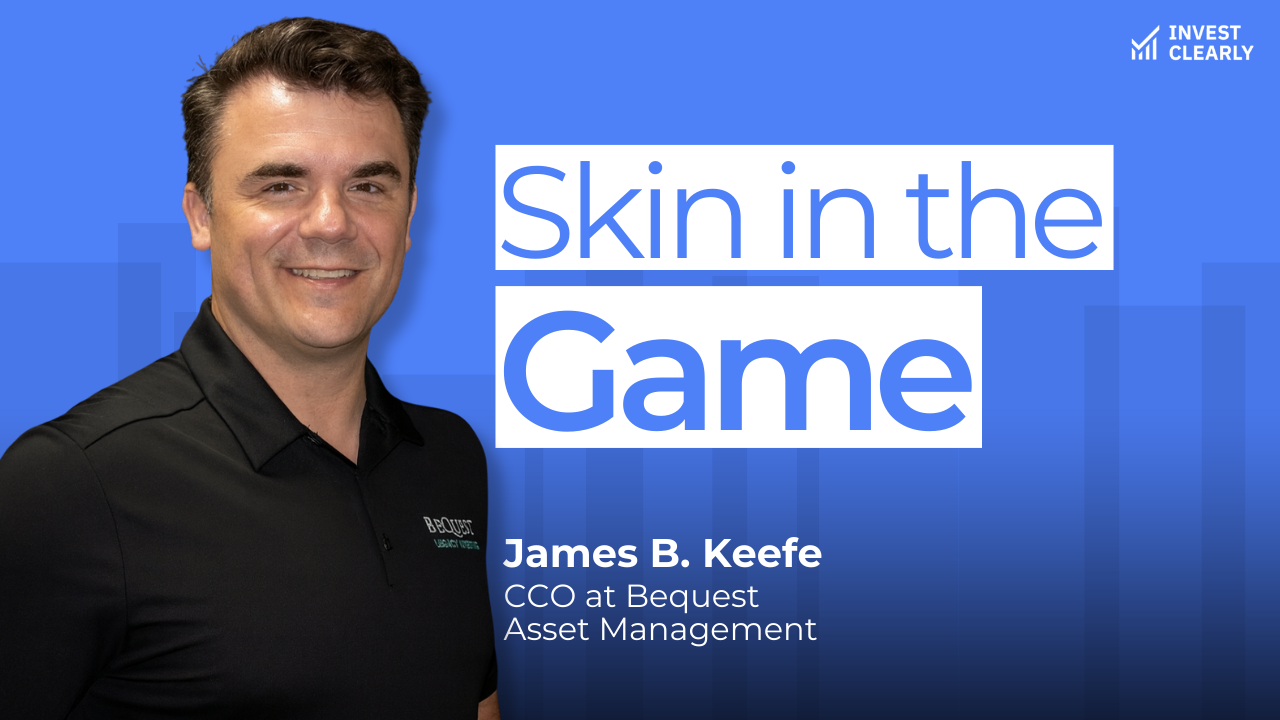
Founder Engagement and Skin In the Game with James Keefe
Never miss an Invest Clearly Insights article
Subscribe to our newsletter today
In this conversation, Joe Guidi interviews James Keefe, Chief Commercial Officer of Bequest Asset Management. They discuss the evolution of Bequest, James's unique journey from acting to finance, and the importance of trust and communication in passive investing. James shares insights on the significance of founder involvement, effective investor relations, and the lessons learned from past investment experiences. The conversation emphasizes the need for transparency and education in the investment process, as well as the evolving nature of passive investing.
Founder Engagement and Skin In the Game with James Keefe
[00:00:00] James Keefe: Why should past investors trust your process right now? I don't know if there's anything really passive. There are two things in life you can't mess with: money and health. We happen to have 50% ownership of our AUM, so only 50% is external capital. If you invest with Bequest, you're in a preferred mature position. What does that mean? You get paid first, before the GPs do.
[00:01:09] Intro: Investors and operators, welcome back to the Invest Clearly Podcast. I'm the CEO of Invest Clearly, Pat Zarella. In this GP episode, Chief Strategy Officer Joe Greedy sits down with James Keefe, Chief Commercial Officer at Bequest Asset Management. James shares how the firm began with five friends investing their own capital and grew to serve more than 220 investors. He reflects on his transition from LP to GP and how that experience shapes his approach to investor communication. They discuss Bequest's vertically integrated model, the role of founder involvement, and how they've structured offerings to include both accredited and non-accredited investors. Let's get into it.
[00:01:43] Intro: James, good to see you.
[00:01:56] James Keefe: Joe, what's up?
[00:01:57] Joe: Really looking forward to this conversation. I've been wanting to talk to you since I started doing these podcasts. I love the approach you guys are taking at Bequest and looking forward to diving in.
[00:02:10] James Keefe: Awesome, man. Thanks for having me.
[00:02:12] Joe: Can we start with a quick overview of Bequest for those who might not know you?
[00:02:20] James Keefe: Bequest Asset Management is here in Sarasota, Florida—the epicenter of the financial world, right? A lot of people don't think south of Tampa is where you launch an asset firm. But we're one of the few in the area. As everyone may know, the migration to Florida has been fast and furious the last few years. If you haven't been to the state in a while, it's changed a lot.
[00:02:43] James Keefe: The company's been around for five years. Martin Saenz and Sean Munoz are the two core GPs. They've been investors since they were born, it seems like, but they've been investing since 2008. Martin is a well-published mortgage note investor. Sean started doing the slumlord thing, then spent 20 years in corporate America on the tech side. They got together around note investing—that's where the business started. They didn't even launch a fund for quite some time. They were just doing it for themselves.
[00:03:20] James Keefe: The first fund launched about five years ago. I think that's important. It's a company that started as investors, so they built this to generate their own wealth. When they got good at it, they said, "Hey, let's open this up. Let's build a company. Let's invite some family and friends around." Now it's grown to 220+ investors, and it's become its own asset management firm.
[00:03:47] Joe: Got it. Could you walk us through your role and where you entered the picture?
[00:03:52] James Keefe: It's kind of wild. I started, believe it or not, as a failed actor in LA after college. I had this dream...
[00:04:07] Joe: Give us the three-minute version.
[00:04:10] James Keefe: Real quick: I was the mascot for the University of Wisconsin—Bucky Badger. They flew me out to California to do a commercial, and I got caught up in this dream of wanting to be an actor. I struggled for years, moved to LA, was cast on this show called Hang Time. You're young, I might be dating myself. I finished that chapter of my life, got an MBA, grew up, and joined pharmaceuticals for 20 years. Most of my career was in pharma.
[00:04:40] James Keefe: But on the side, I was investing. I started in the equity market, scaled my real estate portfolio, and built up enough passive income that I actually retired out of pharma and moved down here. My partner said, "You're sitting by the pool talking to the dog. You need to do something more." I wanted to throw myself into the financial sector but didn't know how. I came across Bequest three years ago, met Martin and Sean, and said, "Hey, if you need help, I'd love to grow your firm."
[00:05:24] James Keefe: As a limited partner, I wanted to learn how to invest and grow wealth beyond just the equity market and real estate. I wanted to learn about private credit, private equity, note investing—other ways to generate wealth outside the traditional channels. That's been my journey over the last three years. I'm now the Chief Commercial Officer. I head up all communications and investor relations, trying to take care of our new and existing investors, making sure they're having a good experience.
[00:05:47] Joe: So you retired through passive investing and then came back to it?
[00:05:59] James Keefe: I don't have to be here. I don't know what I'm doing, Joe.
[00:06:02] Joe: Why are you on this podcast right now? What are you doing with yourself? You're bringing that LP perspective to your interactions with LPs?
[00:06:15] James Keefe: Yeah, that's what makes me feel great about what I'm doing. I've started to learn the industry and gotten a peek behind the curtain, even on the financial advisor side. There are a lot of incentives out there. You could probably make this argument in any industry. I saw it in pharma as well. It's really interesting when you get behind how people are incentivized.
[00:06:35] James Keefe: The good thing is I give real talk on this podcast. I'm very real with people I interact with. I don't like to go into a deal or anything until I understand what's going on. Joe, if you were interested, we would talk about what you're trying to achieve, what your goals are. Even if the fund offerings we have don't make sense, I've got plenty of network—I can refer you to other people. I'm just trying to get through this world together, help people grow wealth so they can become more free and not be attached to a job because they have to earn a living.
[00:07:09] James Keefe: At this point in my life, I get a lot of reward from helping people achieve their goals. It's a really cool thing. That's why I like being in that position. I don't feel like I have to do this—I actually want to do it. Along the way, I get an enormous amount of education and empowerment from it.
[00:07:41] Joe: That's cool. Let's dive more into Bequest and the process. Obviously, trust is an important element of the passive investing journey. There's some tumult around it right now based on some firms having bad press. We've seen investor confidence shaken, decision cycles move slower. Why should passive investors trust your process?
[00:08:13] James Keefe: I feel the whole passive thing is interesting. I don't know if there's anything really passive. You have your active income—you're working, you have your W2, you're trying to live below your means and use that money to invest in things that hopefully take the pressure off of having to work.
[00:08:35] James Keefe: But if anyone's bought real estate and had a massive portfolio, that whole thing is an animal. So you're like, "Okay, is there another way?" Well, there are all these syndications and operators, but that whole game is different. If you buy a property yourself and control it, and that asset turns out one way or the other, it's on you. But how do I evaluate these thousands of operators out there?
[00:08:56] James Keefe: It's easier to find a rating on Hotels.com to figure out what hotel to stay in. But if you're trying to figure out basic stuff around whether your LPs are satisfied with the returns you're marketing, it's really hard to find that information. I think that's what's being built out here, which is phenomenal what Pat's doing.
[00:09:25] Joe: We are trying to solve that problem.
[00:09:28] James Keefe: It's the hard questions that I feel like need to be asked. That's probably the biggest thing I've learned—I've seen behind the scenes of how hard an asset firm has to work to deliver the returns. It's more than just marketing. It's not easy work.
[00:09:43] James Keefe: Our process is very rigorous on the inside. An investor doesn't see that. They pretty much get their monthly distribution or monthly report that shows we're hitting our marketed returns. But I know how hard that is. There are several things about our process—and it's also people. The founders of the company are still very much 100% engaged. That's one of my big questions: Where are the founders? Are they still working the grind? Are they going after it?
[00:10:14] James Keefe: Second question is how much skin in the game? We happen to have 50% ownership of our AUM, so only 50% is external capital. That's sizable skin in the game. We invest way early in an asset strategy before we invite external capital in, because I know the heartache. There are two things in life you can't mess with: money and health. I knew that from pharma. You can't push out a medication and then have it go sideways.
[00:10:54] James Keefe: From an asset performance standpoint, you absolutely have to have some skin in the game. But I would say the philosophies—understanding what a firm's investment philosophy is—we happen to be cashflow investors. We look for assets that are cashflow positive, and we analyze an asset's cashflow performance before we even acquire it.
[00:11:18] James Keefe: Then we control it. We vertically control that asset. We're not going to leave that to a secondary operator that may or may not perform the way we want it to perform. And we make sure it's serving our values. We want to invest in things that serve the community. When we invest in mortgage notes, they're performing—we want that homeowner to stay in their home. We don't look to foreclose. On the energy park side, we make sure these are renewable sources that are doing good by the community.
[00:11:52] James Keefe: The last thing is we try to keep it simple. We try to keep it around assets that people need. Real estate and energy is where we're comfortable. I think it's great if an asset firm goes outside of its historical track performance and tries to diversify, but as an LP, you've got to be careful about that. Tell me about the talent. What are you bringing in to make sure you understand that asset class if I'm deploying capital into a new area where you're shifting your strategy?
[00:12:11] James Keefe: These are just hard questions that I've learned, as now an LP when I invest. I'm not afraid to ask: Where are your founders? What's their background? What's your investment strategy? Show me your track record. Show me where your capital's being deployed. How do I know I'm getting into a good deal?
[00:12:37] Joe: It's really interesting. We collect reviews from LPs, and we've seen reviews come in recently where LPs are being very direct around those issues—founder involvement, whether they feel like they're taking accountability. The other thing is a lot of low reviews in the fundraiser environment—firms that appear to be capital firms raising for other folks. I think that gets to the skin in the game issue. What I hear you saying is when an LP is evaluating an investment, they should be looking for how involved the founder is, both their time and money.
[00:13:25] James Keefe: Yeah. And are they just doing a deal? I remember years ago I was at a BiggerPockets conference when I started to entertain the idea of maybe doing a syndication. It's interesting—you start coming across these deals: "Do this syndication, do this one, do this one." It took me a while to mature and understand private equity firms and private asset firms. I'm not talking BlackRock or KKR, because you can go to a financial advisor and they'll recommend some 7% deal.
[00:14:06] James Keefe: But if you're really trying to go emerging manager, boutique manager, get maybe a richer deal directly with a founder—this is where I think our founders are scaling a company. Are you building a company that I'm also investing in, not just a deal? That's where the deal pitching or the hired hand starts to fall into a value thing too.
[00:14:35] James Keefe: That's where the second half comes in—who do you want to go ride with? Do you want to invest in 20 different deals with 20 different operators, or are you trying to look for a handful of operators that are scaling a business, that are going to be the next generation that you can go into the private market with and grow your wealth outside the public markets?
[00:15:37] Joe: Let's talk about communicating that. As Chief Commercial Officer, you're in charge of investor communications and relations. How are you communicating that to your existing LPs and new folks? You guys are at events, doing lots of things—it's a competitive environment. How are you building trust with LPs early?
[00:16:00] James Keefe: I get on my team as well, but if they start deal pitching early, I get really frustrated. As an LP, when I go to conferences, you just feel it. You're like, "Oh my gosh, we're going to Limitless and I know it's going to be a pitch fest." Everything's up and to the right, which is not true, and you get overwhelmed by all this information.
[00:16:22] James Keefe: What I think is unique is when you run into somebody and you have a conversation around, "Hey, Joe, what are you trying to do? Are you trying to grow? Are you trying to get more passive? What are your interests? What is your asset?" You might be interested in storage facilities, and we don't do anything like that, but I know three really good operators. I don't get incentivized by referring you to them, but I'm just trying to help you get to your goal now that I understand what your goals are and interests are.
[00:16:55] James Keefe: To me, it's education, education, value. Give it away. We hand out all our free stuff. There's not this "Here's a $500 packet, and if you go in today, it's $99." Behind the scenes, they're not going to push a deal, or you download a white paper and next thing you know, you get eight calls hitting your cell phone pitching the deal.
[00:17:25] James Keefe: We just give stuff away. I know it's longer and there's pressure and people are trying to raise capital, but we find that the investors that really stick with us are the ones who have attended our webinars and conferences. We put out content, educate people around due diligence, around assets, around investment thesis—fancy things like that.
[00:17:52] James Keefe: A relationship is built from there. If a deal comes up and it makes sense, fantastic. If not, no worries. We're both stronger and empowered by sharing education amongst each other. That's a principle we lead with—just adding value, giving it away, and trusting that when a deal comes up, there's a chance that someone may or may not invest, depending on where they are and what their goals are. We're totally okay with that philosophy.
[00:18:29] Joe: I think creating alignment is really important between what the investor's trying to accomplish and what they care about, and your offer early. As a lifelong seller—most of my career has been in sales—there's nothing more obnoxious than someone coming on and talking about the thing they have to offer without any idea of whether it connects with what that person needs. You've got to figure that out first. I think that's great.
[00:18:59] Joe: Could you share a time where you feel like, either in your own investing as an LP or in the leadership team of an asset management firm, LP trust was lost?
[00:19:26] James Keefe: As an investor, I got caught up in the Peer Street stuff. They went into bankruptcy, so I got a little burned. This was when everybody could just put money in whatever and it seemed like you could make money. This was before I got into the private asset world. I was just a limited partner working in pharma. I'd scaled my real estate. I was like, "What else?"
[00:19:49] James Keefe: This was when the FinTech companies were coming out and these bridge loans. The rates were low and I was making 10-11%. Then all of a sudden, boom, it dried up and the deal flow got wiped out. I pulled most of my money out. I still have a little bit caught up. They've been in bankruptcy for two years, and I didn't pay attention to my position on the investment. My position on the cap stack was really low, probably at the level of common stock. That's why I'm stuck with a little bit of money still in there, just waiting. Maybe I'll get it all back, who knows?
[00:20:26] James Keefe: At Bequest, we've never missed a payment, but I think where we ran into some challenges is we've had explosive growth. We literally went from 100 investors to 230.
[00:20:54] Joe: Over what period?
[00:20:55] James Keefe: Like nine months.
[00:20:56] Joe: Oh, right.
[00:20:57] James Keefe: It just blew up when we launched our Reg A. Not a lot of firms do Reg A. We do non-accredited and accredited, so we have both now. That adds regulatory compliance. We wanted to go there with the theme of trust. We're now a licensed registered investment advisor firm in the state of Florida. Doesn't mean I'm an advisor, but we got that shingle because we're now held to a fiduciary responsibility to our investors.
[00:21:30] Joe: More scrutiny, right.
[00:21:32] James Keefe: Yes, but we're scaling. If you're going to scale, you've got to bring everything—you can't just raise capital, you've got to bring a whole structure with you. What was missing for us was a concierge team. We underestimated what investors, in particular non-accredited investors, may need that are coming into our funds. We quickly had to put together a concierge team, white glove service.
[00:21:51] James Keefe: What dawned on me was, yes, it's great we promote these great yields and we've got these great products, but you've got to bring the investor experience along with you. Now when folks survey us or rate us, the concierge team gets mentioned in equal footing to our product. That was something we learned along the way for sure.
[00:22:19] Joe: I think that's something that's emerging as an idea amongst GPs—they're starting to come around to the idea that the LPs are not just... yes, you build great products, you work really hard to deliver returns. That is not actually enough. There needs to be more than that. This is a relationship.
[00:22:39] James Keefe: Yeah.
[00:22:40] Joe: There's handholding beyond the check, and I think it's really astute for you guys to recognize that. I've been talking in my other hat a lot to GPs about, you know, you had a plan past the funding. What does the communication strategy look like post-funding?
[00:22:59] James Keefe: I know, right? It's about incentives. If all you're trying to do is get to an AUM or cap raise goal, then yeah, you look around and all these GPs have a bunch of sales folks. But if you've got an incentive—which we have a rating of satisfaction—then it gets a little scarier. You're like, "Ooh, wow, what are they going to say based on their year or so experience beyond the yield?" Maybe they're happy with that, but did we communicate to them in a very open and transparent way? Did we deliver our quarterly investor calls in a way that makes sense?
[00:23:39] James Keefe: To me, the most critical part is usually that first 90 to 120-day window. You deploy your capital, you wire your funds, you're sitting there, you assume it's landed. If a GP doesn't have communication coming back to you as to the steps of what that deployment period looks like, when that return happens, and then once you get into a regular cadence, it feels good.
[00:24:00] James Keefe: That whole second half, I think, is something that—I know people that do it really well—investors really appreciate that ongoing communication, especially when you're now having to keep an eye on the operator. That's the passive investing side. Maybe you're not scaling your own properties, facilities, or mobile parks. You're going in on syndications or with a private asset firm. Now your job's still not done. You still have to keep an eye on your operator, how well the firm's performing, how it's growing.
[00:24:36] Joe: I think it's interesting—you mentioned you scaled really quickly, and that's when you realized you had this communication gap. We actually should be publishing shortly what we call an Invest Clearly Insights. We did research, qualitative and quantitative, based on the reviews. One of the pieces is called "The Communication Gap." It basically highlights that larger firms are getting really good ratings on pre-investment communication and really bad ratings on post-investment communication. So it's something that actually gets exacerbated as firms get bigger.
[00:25:19] James Keefe: That's going to be great. I don't know if you guys are going to offer that to GPs, but GPs need to hear that.
[00:25:25] Joe: It'll be out there for everybody.
[00:25:27] James Keefe: I think that's awesome. It's probably the way they're structured too, or incentives. Everyone probably has some sort of scorecard. What numbers are you looking at? I think AUM and capital raise is the main thing everyone talks about. This is where I feel like, being an LP-GP insider, I'm always the voice of the customer in this case. That goes back to my career, being, as you were saying, Joe, a seller, always keeping the customer in mind.
[00:26:03] James Keefe: I don't know if in the financial services world that exists everywhere—I feel like it's hit or miss. But I'm always looking at best practices of how we can improve the trust and communication to our investors. I think that's vital.
[00:26:20] Joe: I couldn't agree more. All right, so I want to hit you with a couple other questions. What's one metric you think all GPs should publish? You talked about a net promoter score, like a quality score on your team. Is that where you would go, or what metric do you think GPs should be putting out there?
[00:26:46] James Keefe: Everyone sort of leads with a track record and their AUM. If you get to "we're about to cross over $100 million," like, whoa, now you've checked all these boxes. I'm like, I feel like I haven't changed at all. You're still just kind of grinding it out.
[00:27:06] James Keefe: I don't know if it's a metric, but we're talking about an education gap. I'm going back to the challenge I ran into with Peer Street. I just think being very clear with investors as to the position they have with the structure of the deal—there's some sort of weird language out there in the private asset world that confuses investors.
[00:27:33] James Keefe: To me, if you were to invest with Bequest, you are in a preferred return position. What does that mean? That means you get paid first. But isn't there a bank involved? No, we don't have any leverage. It's actually equity buildup, and we own the rest of the AUM. So you get paid before the GPs do.
[00:27:58] James Keefe: But does that mean there's more or less? It just depends on how we perform. Our LPs get paid first. We are going to pay you to that market return first. We are going to ride or die to make sure we deliver on that. As an emerging manager, you can't afford to miss. That's why you move down into the emerging boutique. Once you go into large firms, the deal's watered down a bit. People miss things and they're like, "We'll get you on the next round."
[00:28:17] James Keefe: But you're an emerging, fast-growing emerging manager—you can't afford that. If you get a review on any platform that's less than five stars, you're going to have to deal with that. You've got to ride or die with that. A lot of our investors, at least I think, appreciate that we're very clear on the position that they have when they come into the deal, what that means, and where the risk is.
[00:28:32] James Keefe: Because there are deals out there where, if you don't ask the right question, the GP might be getting paid first. I don't know. Maybe there's some sort of risk shift going on and you're not even aware of it because it's in the fine print on page 75 of the PPM. There's a lot of marketing things that I see that aren't as clear. I would just like to see better improvement on behalf of the GPs to clarify to the LP what the structure is.
[00:29:15] James Keefe: And as an LP, don't be afraid to say, "I don't understand what you're saying. Break this down in very simple terms. If I were to invest with you at this marketed return, what position do I have, and why?"
[00:29:27] Joe: I think that's really good. We've seen some LP influencers on LinkedIn starting to write about this—by the way, the asset doesn't need to go to zero for you to lose your capital, especially depending on where you are on the cap stack. Just highlighting the fact that, depending on fees or position, there's still room for the GP and others to make lots of money when their investment goes to zero if they don't know what questions to ask.
[00:29:59] James Keefe: Yeah, and the deal might suck. As an LP, do you know what a great deal looks like and what's not? The last three years working for Bequest has really opened me up. I think we have pretty good deals, but I'm exposed to all these things. I know how deal structures are put together. I know where the risk shift may happen.
[00:30:16] James Keefe: Out to the LP community, I would say—I know this is finance. If you don't come from a finance background, it can be painful. I didn't have a financial background. It has been painful, but I've learned so much. When I see a deal and I understand what position I have, I have a better understanding of whether this is a good deal or not. I don't get caught up in the fancy yield number, because that's what people get drawn to and they assume that's just going to magically happen. No—assume things don't get delivered. Where are you positioned so you know if that's going to be a good deal for you?
[00:30:52] Joe: That makes sense. All right, last question. This is one Pat loves: What's one myth about passive investing that needs to die?
[00:31:02] James Keefe: I think the term passive. I mean, I love it though. I'm a cashflow investor—that's a little bit different than passive. There are different levels of passivity. Some people think building a real estate portfolio is passive. I've been there, done that. It is not passive.
[00:31:21] James Keefe: So now I'm going to go the REIT route. Well, that's volatile—not consistent, predictable. Now I'm going to go the dividend route. Well, that's not quite predictable either. A company can always change its dividends, and there are ways to figure that out through closed-end funds and all that. So now I'm going syndication or private asset, private operator. I'm just going to put my money in and totally turn the brain off. That doesn't happen either.
[00:31:35] James Keefe: I think you have to be actively involved, but there are different passivity levels on the spectrum. In my experience investing in all different kinds of things, what we do is probably a bit more passive than others—the mailbox money concept. But I'll tell you, you've got to pay attention to the company performance. Once you deploy your capital, you've got to stay attuned to their strategies. You've got to visit them, be on their investor calls, read their documents, read their updates, and still be actively invested alongside them.
[00:32:15] James Keefe: I think this passive—I still love it though, because I love being in a position where at the beginning of the month I've got this income that comes in that's not correlated to my active income. The beautiful part of that passive investing philosophy is still there. It takes the stress away from whether I like working here or not—I'm good, I can take care of my family.
[00:32:36] James Keefe: But I know now at this point in my career that I'm always going to need to be actively involved. Not all of it is things that I love, like reading through net asset valuations or proformas and company updates and things like that. But hey, with AI and all that kind of thing, I've got all kinds of cool tools that I can upload documents and have it spit out things that make sense for me.
[00:33:14] James Keefe: But that's the thing—passive investing, how much passivity is really there? There's always going to be some sort of active involvement you need to have.
[00:33:26] Joe: That's really interesting. Well, thank you for your time today. By the way, that's a really interesting last note because I think the thing about passive investing today is the passivity. Thank you for your time. If people want to learn more about Bequest, where should they go?
[00:33:45] James Keefe: Just bqfunds.com is our website. All of our contact information is on there. Browse around, check out who we are. We communicate our investment philosophies first, and then a little bit about our deals. We do these happy hours and webinars—all that stuff is posted on our website. Just go to bqfunds.com, check it out.
[00:34:06] Joe: Awesome. Thanks, James.
[00:34:08] James Keefe: Cool, man. Thanks, buddy.
Written by
Invest Clearly empowers you to make informed decisions by hosting unbiased reviews of passive investment sponsors from verified experienced investors.
Other Articles
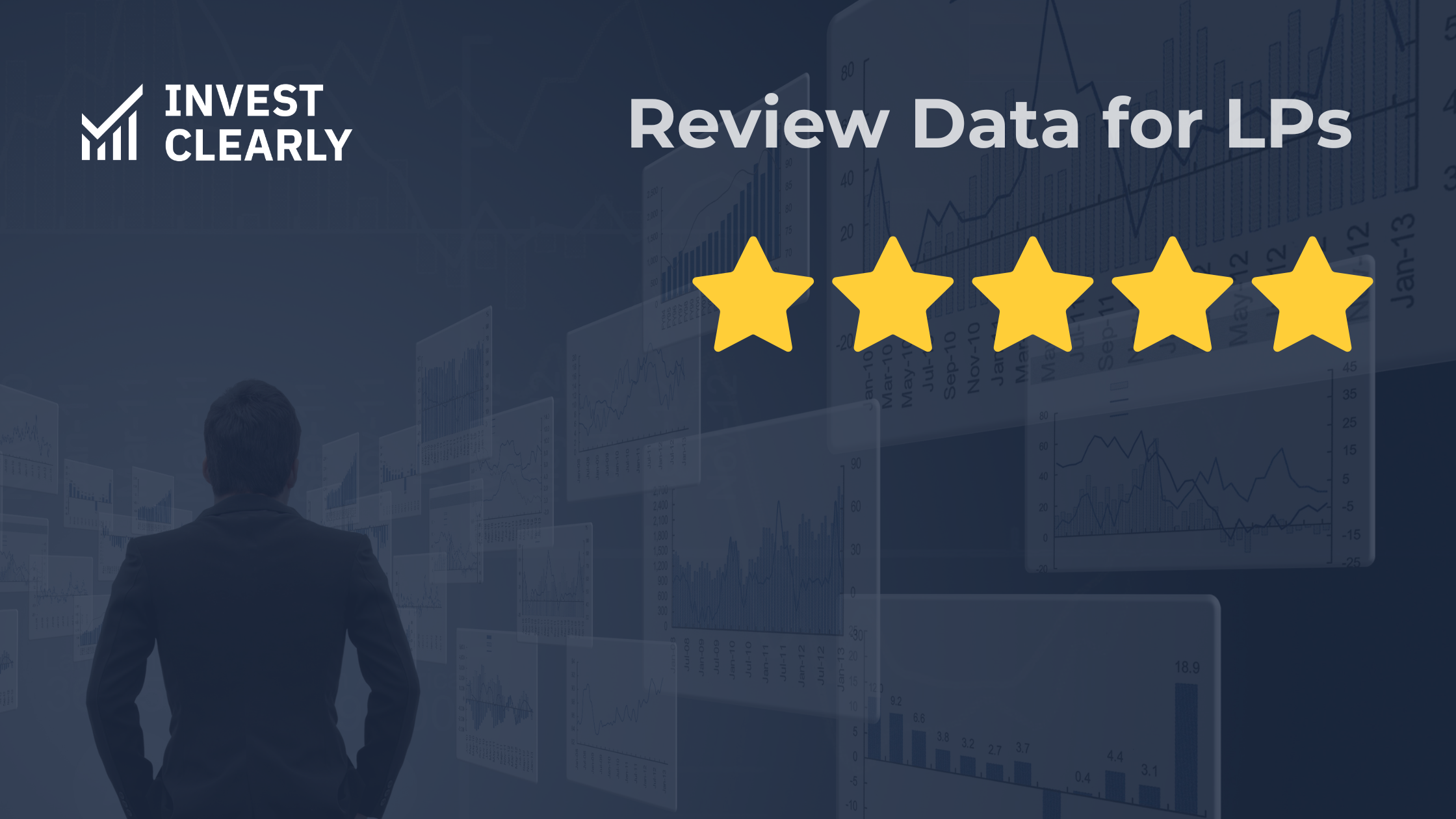
Investor Experience Index Q3, 2025: LP Takeaways
Discover quarterly insights of how LPs rate their experiences with GPs. Get data-driven questions to use when evaluating GPs.
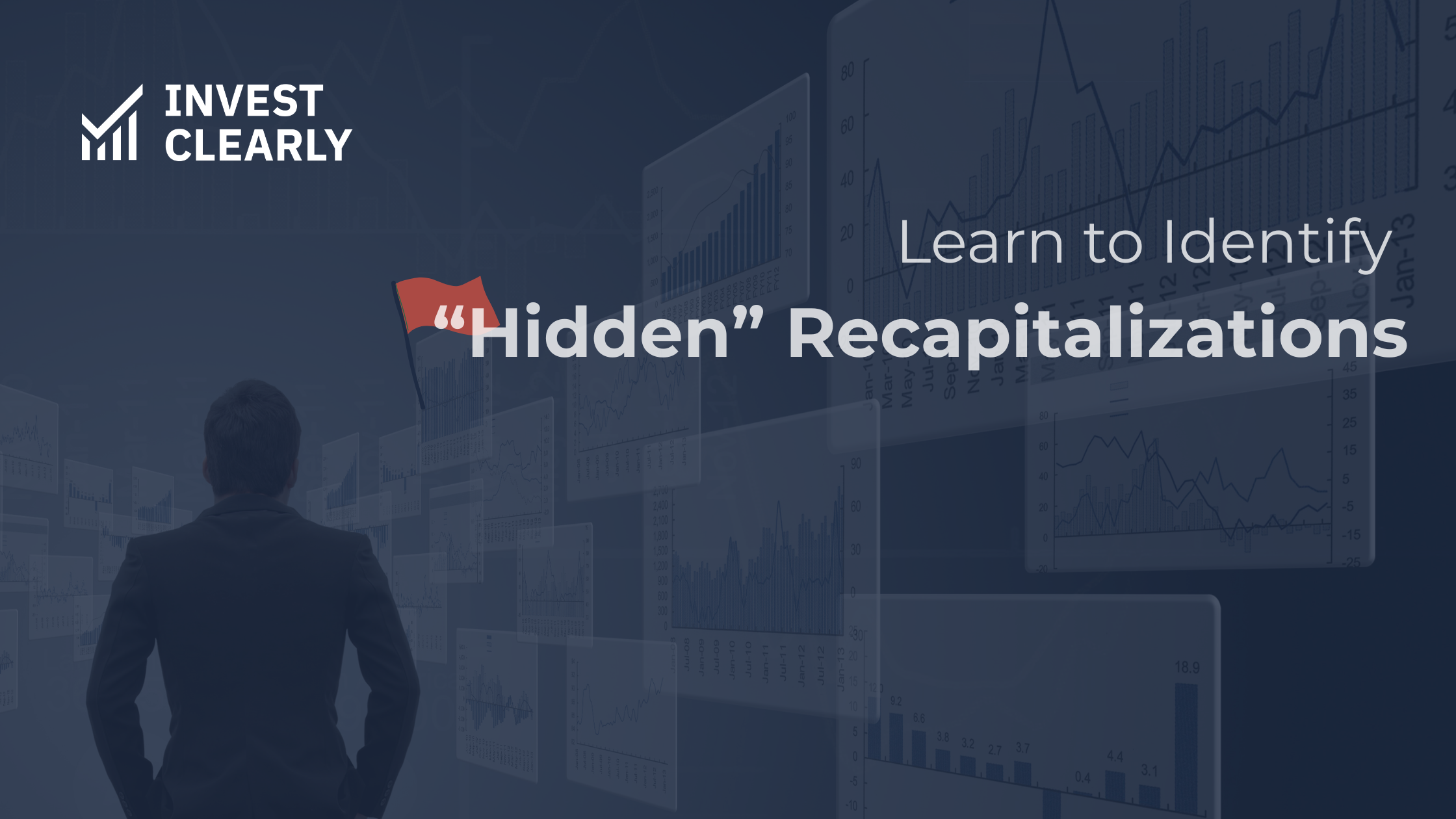
Real Estate Recapitalizations—What Passive Investors Need to Know
A recapitalization is a restructuring of a property's capital stack (the mix of debt and equity that finances an investment). While they can be legitimate business strategies, transparency can be an issue.
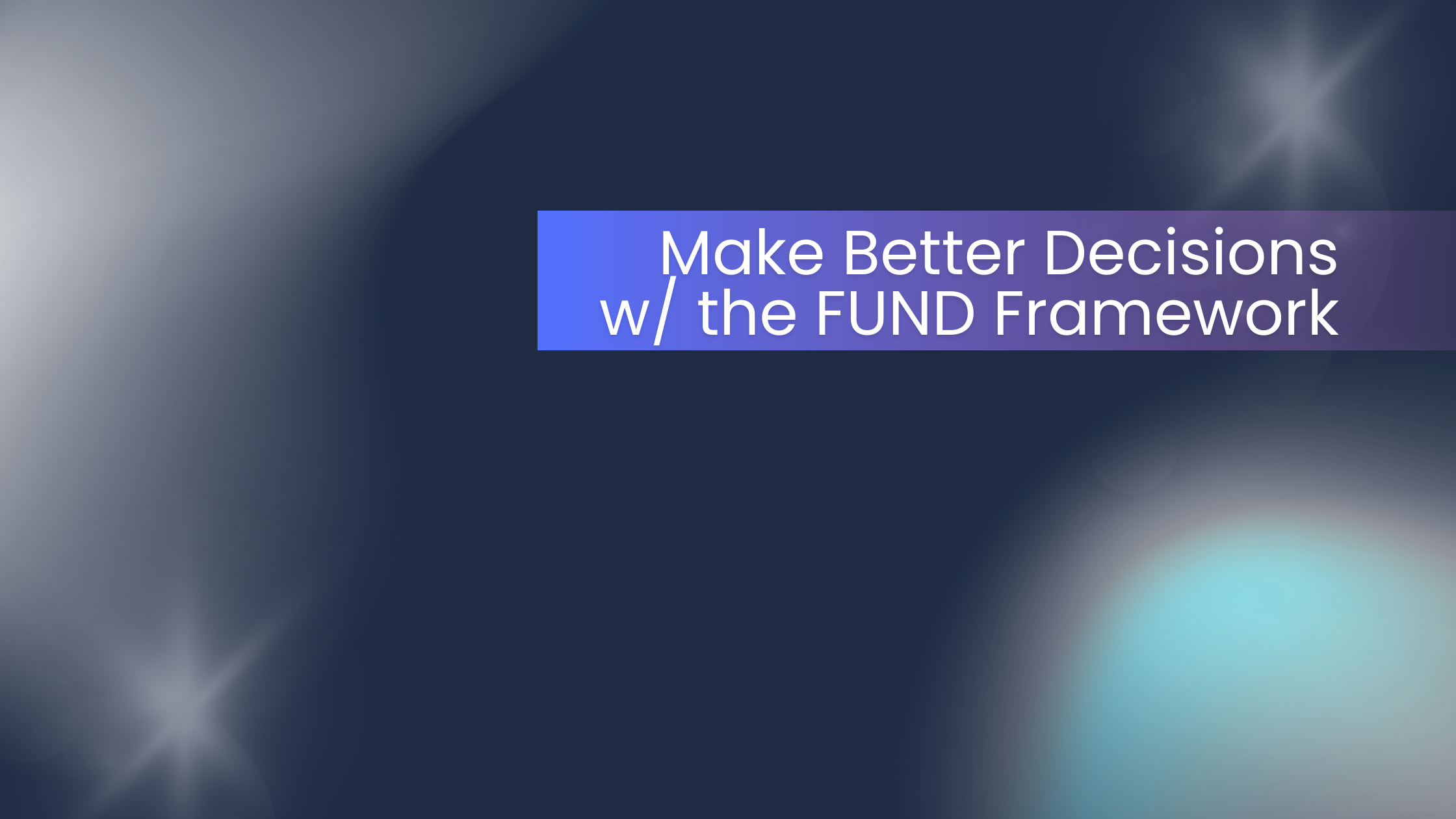
How to Evaluate a Potential Investment Using the FUND Framework
The FUND framework is a simple way to evaluate opportunities by looking at four pillars: Financials, Underlying Assets, Notable Differentiator, and Delegation of Responsibilities.

What Needs to “Die” in Passive Investing – According to Guests of The Invest Clearly Podcast
Get the answer to the closeout questions of each podcast episode: “What do you think needs to die in passive investing?” The answers are wide-ranging, from misconceptions about risk, to misleading marketing tactics, to structural issues in how deals are presented.

Passive Real Estate Investing Advice from Experienced LP Investors
Experienced LPs shared their most valuable lessons, drawn from years of investing across various asset classes and sponsor relationships.
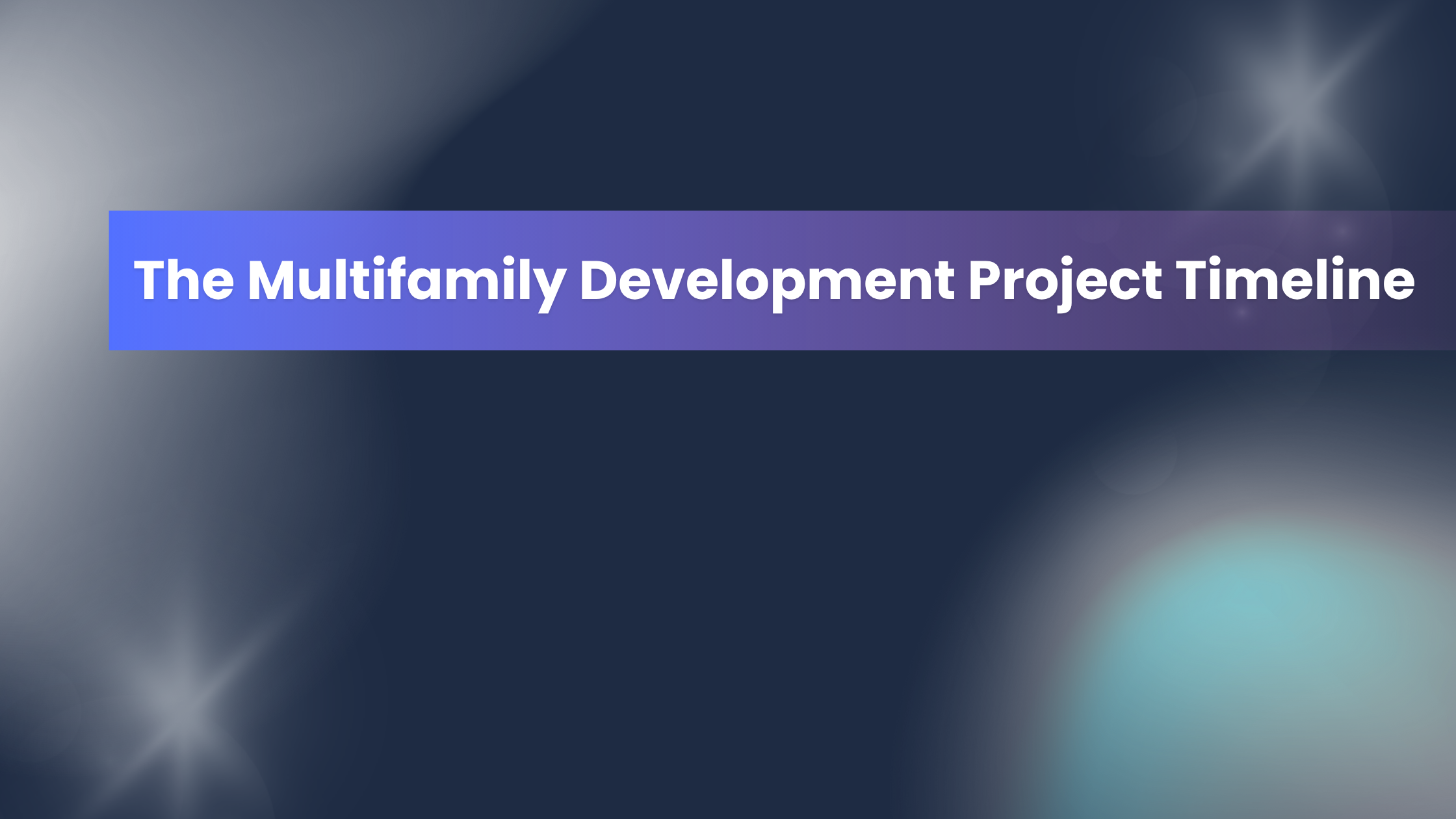
From Land to Lease-Up: The Lifecycle of a Multifamily Development Deal for LPs
This guide walks you through the typical timeline of a multifamily development project from the LP perspective. Learn when investors come on board, what happens during construction and lease-up, and how profits are realized at exit.